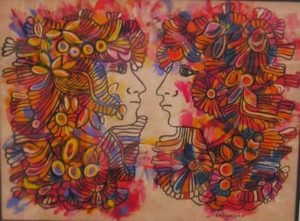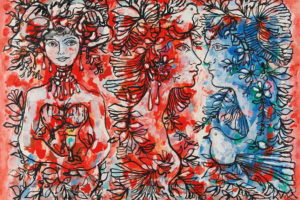 RENÉ PORTOCARRERO Y SU PROFUNDA HUELLA EN LA HISTORIA CULTURAL CUBANA.
RENÉ PORTOCARRERO Y SU PROFUNDA HUELLA EN LA HISTORIA CULTURAL CUBANA.
“El Porto”, como le decian sus amigos más cercanos y cuyo verdadero nombre era César Modesto de la Caridad Villiers Portocarrero autodidacta, nació el 24 de febrero de 1912 en el populoso distrito, humilde y Cerro de La Habana, y tan sólo 12 años realiza su primera exposición en el Liceo de La Habana y en 1945, también por primera vez se exhibe su trabajo a través de fronteras en la galería Julian Levy de Nueva York.
Principios relacionados con “Pintores y Escultores de estudio gratis” en La Habana y se hace amigo del pintor Mariano Rodríguez y está estrechamente vinculada a la generación de poetas llamado “Grupo de Orígenes”, en clara alusión a la revista del mismo nombre, sin duda, marcó hitos importantes en la cultura nacional y que se asocian con nombres como Cinto Vitier, Fina García Marruz, Eliseo Diego y José Lezama Lima, entre otros.
Portocarrero, también publicado en varias revistas literarias dibujos como “Verbum” y “Silver Spur” y durante ese período escribió los libros “Las máscaras” (1935) y “The Dream” (1939). En 1943 fue profesor de dibujo a mano alzada en la Cárcel de La Habana, donde pintó un mural de temas religiosos y en esos años iniciaron los ciclos de varias de las obras, con títulos como “Interior de la colina”, las Fiestas “y las figuras de una mitología contemporánea. ”
En su tema de promoción estaba interesado, y luego por los festivales de Cuba, tema al que dedicó una serie de pasteles y alrededor de 1950 comenzó a trabajar en la decoración de la cerámica, Taller Experimental de Santiago de Las Vegas. Con esta técnica se llevó a cabo un mural a gran escala, titulado “Historia de las Antillas” a la Habana Hilton (hoy Habana Libre), que todavía existe allí y que es una gran atracción.
En 1951 recibió el Nacional de Pintura por su cuadro “Homenaje a Trinidad”, actualmente en el Museo Nacional de Bellas Artes de Cuba, que marca el inicio de una serie de estampados inspirados en la capital cubana, denominada “Paisajes de La Habana.”
En 1962, inauguró la exposición “Color Cuba” por razones santería afro-cubana y el carnaval – festivales como – fue objeto de otra de sus series más conocidas y reconocidas: “Carnaval”, a partir de 1970-1971.
Un participante frecuente en la Bienal de Sao Paulo y Venecia, a lo largo de su carrera recibió numerosos premios y honores, incluyendo el Premio Internacional Sambra, la Orden de Cultura de Polonia, la Orden de Cirilo y Metodio, otorgado por el gobierno de Bulgaria de 1976, la Orden Félix Varela de la República de Cuba, en 1981, y el Águila Azteca, máximo galardón otorgado por la República Mexicana en 1982.
El 7 de abril de 1985, a los 73 años, murio en La Habana René Portocarrero, considerado uno de los artistas cubanos más importantes que desarrolló un lenguaje de la pintura de estilo realista, casi primitiva conceptualmente poético y figurado.
Portocarrero, que dejó una profunda huella en la vertical y la historia del arte cubano del siglo XX, estaba en posesión de un estilo muy personal y, según los expertos, su obra se caracterizó por “un vibrante colorido barroco raíces.”

www.TheCubanHistory.com < SEARCH - OVER 7,000 ARTICLES ABOUT CUBA.
 RENÉ PORTOCARRERO AND HIS DEEP FOOTPRINT IN CUBAN CULTURAL HISTORY.
RENÉ PORTOCARRERO AND HIS DEEP FOOTPRINT IN CUBAN CULTURAL HISTORY.
“El Porto”, as he was called by his closest friends and whose real name was César Modesto de la Caridad Villiers Portocarrero self-taught, was born on February 24, 1912 in the populous district, humble and Cerro de La Habana, and only 12 years He made his first exhibition at the Liceo de La Habana and in 1945, he also exhibited his work across borders at the Julian Levy gallery in New York for the first time.
Principles related to “Painters and Sculptors of free study” in Havana and befriends the painter Mariano Rodríguez and is closely linked to the generation of poets called “Group of Origins”, in clear allusion to the magazine of the same name, no doubt , marked important milestones in the national culture and that are associated with names such as Cinto Vitier, Fina García Marruz, Eliseo Diego and José Lezama Lima, among others.
Portocarrero, also published in several literary magazines such as “Verbum” and “Silver Spur” and during that period he wrote the books “Las mascaras” (1935) and “The Dream” (1939). In 1943 he was a professor of freehand drawing at the Havana Prison, where he painted a mural of religious themes and in those years began the cycles of several of the works, with titles such as “Interior of the hill”, the Festivities “and the figures of contemporary mythology. ”
In his promotion subject he was interested, and then for the festivals of Cuba, subject to which he dedicated a series of cakes and around 1950 he started to work in the decoration of ceramics, Experimental Workshop of Santiago de Las Vegas. With this technique, a large-scale mural entitled “History of the Antilles” was made to the Habana Hilton (today Habana Libre), which still exists there and which is a great attraction.
In 1951 he received the National Painting for his painting “Homage to Trinidad”, currently in the National Museum of Fine Arts of Cuba, which marks the beginning of a series of prints inspired by the Cuban capital, called “Landscapes of Havana.”
In 1962, he inaugurated the exhibition “Color Cuba” for Afro-Cuban santería reasons and the carnival – festivals as – was the subject of another of his best known and recognized series: “Carnaval”, from 1970-1971.
A frequent participant in the Biennial of Sao Paulo and Venice, throughout his career he received numerous awards and honors, including the Sambra International Prize, the Order of Culture of Poland, the Order of Cyril and Methodius, awarded by the Government of Bulgaria of 1976, the Félix Varela Order of the Republic of Cuba, in 1981, and the Aztec Eagle, the highest award granted by the Mexican Republic in 1982.
On April 7, 1985, at age 73, René Portocarrero died in Havana, considered one of the most important Cuban artists who developed a realistic, almost primitive conceptually poetic and figurative painting language.
Portocarrero, who left a deep imprint on the vertical and the history of Cuban art of the twentieth century, was in possession of a very personal style and, according to experts, his work was characterized by “vibrant colorful baroque roots.”
Agencies/ RHC/ Estrella Diaz/ Internet Photos/ Arnoldo Varona/ www.TheCubanHistory.com
THE CUBAN HISTORY, HOLLYWOOD.

www.TheCubanHistory.com < SEARCH - OVER 7,000 ARTICLES ABOUT CUBA.







